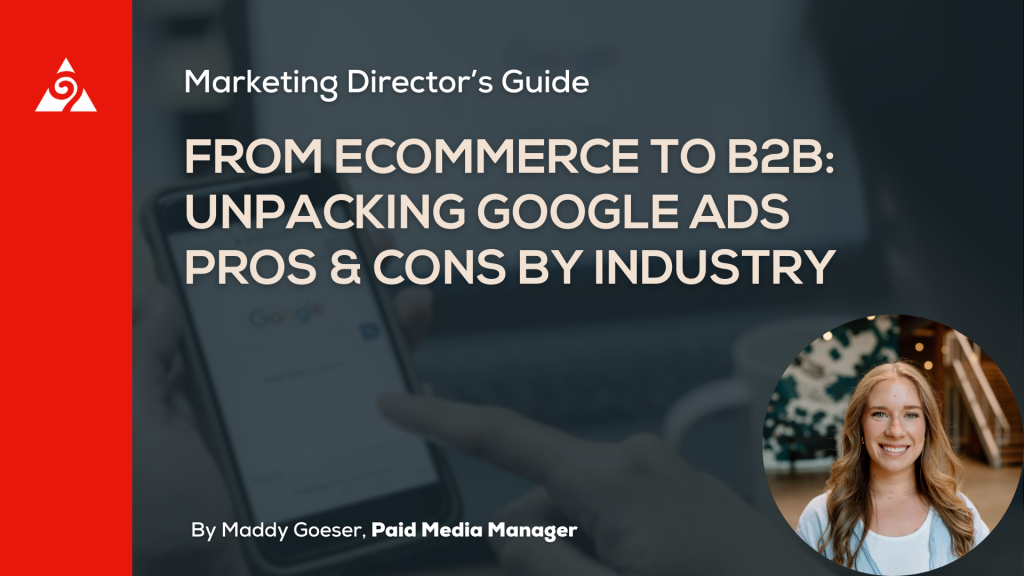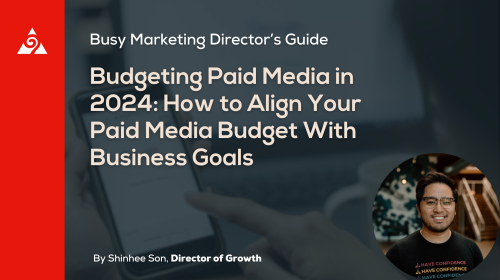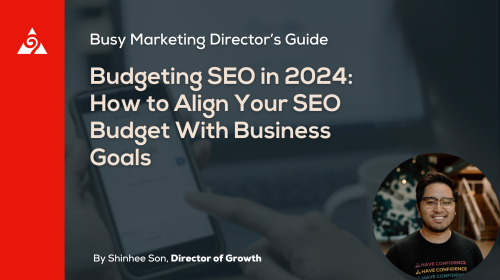If you’re stepping into marketing within a new industry or adapting to a different business model, you may discover that your go-to paid media tactics aren’t performing as well as you’d hoped. This adjustment can be tough, but rest assured, you’re not navigating these changes alone.
We’re here to guide you through each industry’s distinct advantages and challenges, ensuring you’re better prepared to adjust your strategy and effectively collaborate with your team.
What is Google Ads?
Google Ads, formerly Google AdWords, is a comprehensive online advertising platform by Google that enables businesses to display ads across its network, including search results, partner sites, and apps like YouTube and Gmail. It focuses on showing ads to users searching for related products or services using keywords, primarily through search ads, but also supports various formats like display and video ads. The platform offers detailed performance tracking with metrics like clicks, impressions, and conversion rates and integrates with tools like Google Analytics and CRMs for in-depth campaign analysis and optimization.
Key features & benefits:
- All-in-one platform: Manage ads across Google’s vast network, including search engine results pages, partner websites, and apps, in one place.
- Easy performance tracking: With easy dashboards and reporting, you can quickly understand the effectiveness of your campaigns, ads, and keywords.
- Capture bottom-funnel traffic: Create search ads that appear precisely when potential customers search for your brand name, related products, or services.
- Various ad types: Support various advertising formats such as display, video & more, offering flexibility to help you meet different marketing objectives.
- Third-party connections: Integrate Google Ads with Google Analytics and CRMs like HubSpot or Salesforce to determine if your leads are turning into actual revenue.
Google Ads offers small marketing teams a fantastic opportunity to expand their efforts in a straightforward and trackable manner. Yet, you may have subpar results if the person handling your Google Ads isn’t familiar with your business or lacks expertise in best practices.
The Augurian paid media team is well-versed in managing all Google Ad campaign types. Read on to hear about the advantages & limitations that we’ve seen across different businesses that we’ve helped build Google Ads strategies.
When to use Google ads?
Google Ads is a powerful tool for businesses aiming to boost visibility, attract leads, or drive sales. Whether you’re a startup seeking industry traction or an established company aiming for expansion, Google Ads provides precise targeting to reach potential customers throughout their buying journey. It’s especially useful during peak seasons or heightened competition, helping you maintain competitiveness and market share. However, it’s vital to carefully evaluate your budget and goals before starting. While Google Ads can deliver excellent outcomes, aligning your strategy with your business objectives is key to maximizing effectiveness.
See how Google Ads can help you achieve your goals:
- Drive More Leads: Use search ads to grab the attention of people already interested in what you offer. Then, use display or video ads to keep them engaged and guide them closer to a decision.
- Drive Online Sales: Leverage Search, Shopping, and Performance Max campaigns to catch shoppers at different stages of their search. A mix of video, product, and search ads can help persuade them your product is the one to buy.
- Improve Quality of Leads: Link Google Ads with your CRM to track “qualified leads” as conversions and fine-tune your campaigns to attract more high-quality leads.
- Boost Visibility/Brand Awareness: Deploy video ads to introduce your brand and display ads to keep your brand top of mind. Make sure your brand shows up in search results, either organically or through paid ads when people look for you.
Example:
When one of our clients began using Google Ads with Augurian, their confidence in digital marketing soared. Initially, their previous agency was juggling over ten search campaigns focused on more than 15 different website actions, diluting the significance of each conversion.
We simplified their approach by integrating their Google Ads with Salesforce, tracking Sales Qualified Leads (SQLs) as conversions, and streamlining their numerous campaigns into a few robust ones. This shift led to clearer data, making the campaigns more manageable and effective. Almost immediately, there was a noticeable increase in SQLs, and they successfully closed deals, significantly boosting their revenue.
Now let’s dive into the pros and cons of each industry and business model.
Pros & Cons by Industry and Business Model
Ecommerce
Pros of Using Google Ads:
- Drive Awareness and Online Sales: Google Ads can significantly boost visibility for your ecommerce business, driving both awareness and online sales.
- Precise Targeting: The platform offers detailed targeting options based on demographics, interests, and search intent, ensuring your ads reach potential customers most likely interested in your products.
- Dynamic Audience Building: Captures users who are in the process of making a purchase, optimizing ad relevance, and maximizing the return on investment (ROI).
- Visibility in Active Shopping Phases: This strategy places your brand and products in front of consumers actively shopping for the items you sell, increasing the chances of conversion even if you weren’t initially in their consideration set.
- Google Merchant Center Integration: Utilizes the Google Merchant Center to effectively manage product information, enhancing visibility in Google Shopping searches.
Cons of Using Google Ads:
- High Competition and Costs: Popular industry niches face intense competition on Google Ads, which can lead to higher advertising costs and strain budgets.
- Requires Expertise for Optimization: Managing effective campaigns and an optimized Google Merchant Center account demands considerable expertise, time, and ongoing effort for testing and optimization.
- Potential for Lower Conversion Rates: Without proper management and optimization, site traffic from Google Ads might convert at a lower rate compared to other sources, as evidenced by an ecommerce client’s experience before Augurian’s intervention.
Example:
Before partnering with us, one of our e-commerce clients found that their site traffic from Google Ads was converting at a significantly lower rate than that of other sources. Their account faced several issues: too much budget was spent on awareness tactics, their product feed wasn’t optimized for better visibility in search results, and they weren’t leveraging first-party data for targeting. After Augurian took over their account management and made these updates, we observed improvements in click-through rates and conversion rates, and ultimately, their Return on Ad Spend (ROAS) increased.
Local Business
Pros of Using Google Ads:
- Extensive Reach and Precise Targeting: Google Ads enables local businesses to reach a broad audience with the ability to target ads down to specific geographic locations such as zip codes, cities, or areas within a certain radius, ensuring that marketing efforts are focused on potential customers within their service area.
- Customization for Local Marketing: Businesses can tailor their advertising campaigns to the local level, enhancing the relevance of their ads to the targeted audience.
- Performance Max Campaigns: These campaigns help drive traffic to physical storefronts by using device and location tracking to identify effective strategies that lead to in-store visits.
- Real-Time Tracking and Measurement Tools: Google Ads offers tools that allow businesses to track the performance of their ads in real-time, facilitating informed decision-making and enabling continuous improvement of advertising strategies for optimal results
Cons of Using Google Ads:
- Cost Concerns in Competitive Markets: Bidding for keywords in competitive markets can be expensive, which may challenge small businesses with limited advertising budgets.
- Resource and Time-Intensive: Managing Google Ads campaigns effectively requires significant time and effort, which could hinder local businesses that lack a dedicated digital advertising team.
- Risk of Overspending Without Proper Management: Overspending on underperforming ads can lead to poor returns on investment without careful planning and resource allocation.
If you’re leading marketing for local businesses, it’s crucial to approach it with a strategy that includes setting clear goals and budget limits and continuously monitoring and adjusting campaigns based on performance data. Leveraging local targeting options and Performance Max campaigns can be highly effective, but success requires understanding the platform’s complexities and a commitment to ongoing management and optimization.
Service Business
Pros of Using Google Ads:
- Instant Visibility: Google Ads provides immediate exposure for your business, unlike SEO, which requires time to show results.
- Precision Targeting: Tailor your campaigns to reach specific demographics, locations, and interests, ensuring your ideal audience sees your ads, whether you offer local home repair services or catering.
- Real-Time Analytics: Access to detailed performance data allows for ongoing optimization of your campaigns, improving efficiency and effectiveness over time.
- Cost-Effective: A pay-per-click model charges only when someone clicks on your ad, making it a cost-effective advertising option.
- Trackability: Integration with CRM systems allows for tracking from click to conversion, offering clear insight into your campaigns’ ROI.
Cons of Using Google Ads:
- Cost Concerns in Competitive Markets: Bidding for keywords in competitive markets can be expensive, which may challenge small businesses with limited advertising budgets.
- Resource and Time-Intensive: Managing Google Ads campaigns effectively requires significant time and effort, which could hinder local businesses that lack a dedicated digital advertising team.
- Risk of Overspending Without Proper Management: Overspending on underperforming ads can lead to poor returns on investment without careful planning and resource allocation.
To secure or increase your advertising budget, it’s crucial to research keyword competition and costs to estimate expected clicks and conversions.
Augurian’s Paid Media team does this regularly and is a big confidence builder. Despite these hurdles, a strategic and industry-specific approach and continuous optimization enable service-based businesses to fully leverage Google Ads to reach and convert their target audience.
B2B Business
Pros of Using Google Ads:
- Enhanced Visibility and Targeted Traffic: Google Ads allows B2B companies to significantly increase their visibility among potential clients by targeting traffic that is actively searching for their products or services.
- Advanced Targeting and Campaign Options: Google Ads’ sophisticated targeting capabilities ensure marketing efforts are directed toward the most relevant audience, particularly through search campaigns.
- Integration of First-Party Data: The platform’s ability to integrate first-party data across various campaign types, such as search, display, video, and Performance Max, enables B2B companies to reach beyond just active searchers, thereby driving brand awareness and conversions.
- Precise Audience Reach: Google Ads’ precise targeting features boost the efficiency of marketing campaigns, making it easier for B2B companies to achieve their marketing objectives.
- CRM Integration: Compatibility with popular Customer Relationship Management (CRM) systems like HubSpot and Salesforce enables dynamic targeting of email lists, enhancing campaign personalization and effectiveness.
- Detailed Analytics and Optimization Tools: Google Ads provides comprehensive, real-time analytics that offers valuable insights for campaign optimization, including tracking lead conversions. This data-driven approach helps fine-tune campaign strategies and ensure efficient budget allocation.
Top Google Ads Strategies to leverage B2b Advantages
- Optimized Search Ads: This campaign type lets you target very specifically, reaching only those who are looking for what you offer. Make your ads directly address the issues your audience faces. Also, use negative keywords to keep your search terms focused and relevant.
- CRM Integration: Google Ads can link to most CRMs directly or via Zapier. If your sales team consistently updates lead information in your CRM, this setup will reveal which campaigns, keywords, and ads generate high-quality leads. You can then decide which stages of the funnel to enhance. By doing so, you supply Google with information its machine learning uses to boost performance continuously.
- 1st Party Data: You can create audiences for Google Ads by either integrating your CRM or uploading an email list. One approach is to upload a list of existing customers to exclude them, saving money by not advertising to them. Alternatively, you can target a specific list directly or use it to find similar audiences, where your ads reach people who resemble those on your list.
- Conversion Value Estimation: B2B marketers often track multiple site actions as conversions, such as form submissions, phone calls, and video views, with one typically being more valuable. Assign values to these actions (for example, $10 for a form fill and $1 for a video view) and prioritize the most valuable ones using value-based bidding strategies.
- Performance Max: Leverage detailed creative and data, including CRM conversions, to produce dynamic ads on Google’s platforms like search, YouTube, and Gmail. This strategy is ideal for B2B marketers due to its wide reach and precise targeting options.
Cons of Using Google Ads:
- Complexity and Optimization Demand: Google Ads’ complexity can overwhelm you if you don’t have experience. It requires ongoing optimization, demanding significant expertise and time.
- CRM Targeting Limitations: The requirement for a minimum of 1,000 matched contacts for CRM targeting can exclude smaller businesses from this feature.
- Need for In-depth Knowledge: Effective use of Google Ads for B2B marketing requires a deep understanding of its features and accurate targeting, posing a steep learning curve.
- Increased Costs from High Competition: The competitiveness of B2B sectors can significantly raise cost-per-click rates, making it difficult for smaller businesses with limited budgets to compete.
- Budgetary Constraints: The potential high costs necessitate careful consideration of Google Ads within a company’s marketing strategy and budget.
Key steps to address b2b disadvantages
- Calculate the Average Value of a Website Lead
- End of Funnel Start: Determine the average value of a successful closed deal.
- Close Rate Calculation: Over three months (or six months for longer customer journeys or insufficient data), divide the total number of closed deals by the number of websites leads to find your close rate.
- Lead Value Estimation: Multiply your close rate by the average value of a closed deal to estimate the value of a website lead.
- Calculate Total Estimated Revenue
- Use the formula: Number of leads x Calculated value of 1 lead.
- Determine Return on Ad Spend (ROAS)
- Calculate your ROAS by dividing the total estimated revenue by the total amount spent on advertising.
- ROAS Interpretation:
- A ROAS above 1.0 indicates you’re at least breaking even.
- A ROAS below 1.0 suggests you’re losing money.
Google Ads for Small Marketing Teams:
Despite your challenges, Google Ads is a perfect fit for small marketing teams like yours, with 1-5 members. It’s hard to find other marketing strategies that deliver a high ROI, precise targeting, measurable outcomes, and the flexibility for rapid changes as effectively as Google Ads does for you.
If you’re unhappy with your Google Ads account’s performance, it might be time to rethink your objectives or consider getting a new account manager. In small marketing teams like yours, where each person handles multiple tasks, giving digital marketing the undivided attention it needs is tough. This often means campaigns don’t get the focus they require to be successful.
That leads to wasted spend.
Investing in an agency might seem like a big financial step, but it often leads to rewarding outcomes if you find a good partner. Partnering with an agency such as Augurian means you’ll have a team of experts who are well-versed in the newest strategies and bring a wealth of insights from their experience with various businesses.
For someone like you, who is unsatisfied with the basics, an agency can commit the necessary time for ongoing A/B testing to unearth the strategies that genuinely drive your business forward, maximizing your Google Ads results.
How to set up for success with a paid media agency
For a successful partnership with a Paid Media agency, it’s crucial that you share clear goals and details about your target audience. By defining your business goals—boosting website visits, increasing leads, or growing sales—you enable your agency to tailor Google Ads campaigns effectively. Setting specific targets, such as keeping the Cost per Lead below $100, makes your goals measurable. Also, giving your agency detailed insights into your audience helps them pinpoint the demographics, interests, and behaviors that align with your offerings, ensuring strategies perfectly match your audience’s needs.
What’s next?
Google Ads can be a game-changer for all kinds of businesses, offering helpful and challenging aspects. But if your current paid media strategy is not helping you reach your goals, it’s time to pull in another opinion.
If you’ve been nodding along with this blog post and thinking about how your business fits into this digital puzzle, we have an exciting offer for you!
Imagine getting a detailed checkup for your online ads strategy – like a health check for your paid media presence.
Our team of Paid Media experts will do the following.
- Review your Google Ads strategy against our proven best practices
- Share personalized recommendations to make your Google Ads work even better.
- Meet with you to explain our recommendations.
And it’s completely free!
Ready to give it a shot?
- Marketing Director’s Guide to Maximizing Your Google Ads Budget - April 10, 2024
- From eCommerce to B2B: Unpacking Google Ads Pros & Cons by Industry - April 1, 2024
- A Quick Guide to Google Ads Conversion Tracking - April 6, 2022





